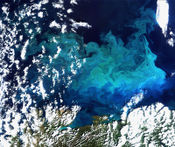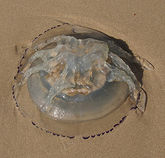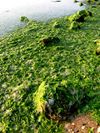Difference between revisions of "Possible consequences of eutrophication"
(→Ecological impacts) |
|||
| Line 5: | Line 5: | ||
==Ecological impacts== | ==Ecological impacts== | ||
| − | |||
==== Increased biomass of phytoplankton resulting in algal blooms ==== | ==== Increased biomass of phytoplankton resulting in algal blooms ==== | ||
<P ALIGN="justify">[[Phytoplankton]] or microalgae are [[photosynthesizing]] microscopic organisms. They contain chlorophyll and require sunlight in order to live and grow. Most phytoplankton are buoyant and float in the upper part of the ocean where sunlight penetrates the water. In a balanced ecosystem they provide food for a wide range of organisms such as whales, shrimp, snails and jellyfish. | <P ALIGN="justify">[[Phytoplankton]] or microalgae are [[photosynthesizing]] microscopic organisms. They contain chlorophyll and require sunlight in order to live and grow. Most phytoplankton are buoyant and float in the upper part of the ocean where sunlight penetrates the water. In a balanced ecosystem they provide food for a wide range of organisms such as whales, shrimp, snails and jellyfish. | ||
Among the more important groups are the diatoms, cyanobacteria, dinoflagellates and coccolithophores. | Among the more important groups are the diatoms, cyanobacteria, dinoflagellates and coccolithophores. | ||
Phytoplankton species require inorganic [[Nutrient|nutrients]] such as nitrates, phosphates, and sulfur which they convert into proteins, fats and carbohydrates. When '''too many''' of these '''nutrients''' (by natural or [[Anthropogenic|anthropogenic]] cause) are available in the water phytoplankton may grow and multiply very fast forming [[Algal_bloom | algal blooms]]. Algal blooms may occur in freshwater as well as marine environments. Only one or a small number of phytoplankton species are involved and some blooms discolor (green, yellow-brown or red) the water due to their high density of pigmented cells. Blooms in the ocean may cover a large area and are easily visible in '''satellite images'''.</P> | Phytoplankton species require inorganic [[Nutrient|nutrients]] such as nitrates, phosphates, and sulfur which they convert into proteins, fats and carbohydrates. When '''too many''' of these '''nutrients''' (by natural or [[Anthropogenic|anthropogenic]] cause) are available in the water phytoplankton may grow and multiply very fast forming [[Algal_bloom | algal blooms]]. Algal blooms may occur in freshwater as well as marine environments. Only one or a small number of phytoplankton species are involved and some blooms discolor (green, yellow-brown or red) the water due to their high density of pigmented cells. Blooms in the ocean may cover a large area and are easily visible in '''satellite images'''.</P> | ||
| − | + | [[Image:Plentiful_plankton.jpg|175px|thumb|left|<small>Envisat satellite image of an algal bloom captured with MERIS (Photo Credit: ESA, 2009)</small>]] | |
==== Toxic or inedible phytoplankton species (harmful algal blooms)==== | ==== Toxic or inedible phytoplankton species (harmful algal blooms)==== | ||
<P ALIGN="justify">'''[[Harmful_algal_bloom | Harmful algal blooms (HAB)]]''' are bloom events involving '''toxic or harmful phytoplankton'''. These cause harm through the production of toxins or by their accumulated biomass, which can effect co-occurring organisms and alter food web dynamics. Impacts include:</P> | <P ALIGN="justify">'''[[Harmful_algal_bloom | Harmful algal blooms (HAB)]]''' are bloom events involving '''toxic or harmful phytoplankton'''. These cause harm through the production of toxins or by their accumulated biomass, which can effect co-occurring organisms and alter food web dynamics. Impacts include:</P> | ||
Revision as of 14:50, 17 February 2014
Contents
- 1 Introduction
- 2 Ecological impacts
- 2.1 Increased biomass of phytoplankton resulting in algal blooms
- 2.2 Toxic or inedible phytoplankton species (harmful algal blooms)
- 2.3 Increased in blooms of gelatinous zooplankton
- 2.4 Decreases in water transparency (increased turbidity)
- 2.5 Dissolved oxygen depletion or hypoxia resulting in increased incidences of fish kills and / or dead benthic animals
- 2.6 Species biodiversity decreases and the dominant biota changes
- 2.7 Increased biomass of macroalgae
- 3 Human health impacts
- 4 Socio-economic impacts
- 5 References
Introduction
Enhanced plant production and improved fish yields are sometimes described as positive impacts of eutrophication, especially in countries where fish and other aquatic organisms are a significant source of food. However detrimental ecological impacts can in turn have other negative consequences and impacts which are described below. Essentially the entire aquatic ecosystem changes with eutrophication. The diagram below gives an overview on the eutrophication process and its causes and consequences.
Ecological impacts
Increased biomass of phytoplankton resulting in algal blooms
Phytoplankton or microalgae are photosynthesizing microscopic organisms. They contain chlorophyll and require sunlight in order to live and grow. Most phytoplankton are buoyant and float in the upper part of the ocean where sunlight penetrates the water. In a balanced ecosystem they provide food for a wide range of organisms such as whales, shrimp, snails and jellyfish. Among the more important groups are the diatoms, cyanobacteria, dinoflagellates and coccolithophores. Phytoplankton species require inorganic nutrients such as nitrates, phosphates, and sulfur which they convert into proteins, fats and carbohydrates. When too many of these nutrients (by natural or anthropogenic cause) are available in the water phytoplankton may grow and multiply very fast forming algal blooms. Algal blooms may occur in freshwater as well as marine environments. Only one or a small number of phytoplankton species are involved and some blooms discolor (green, yellow-brown or red) the water due to their high density of pigmented cells. Blooms in the ocean may cover a large area and are easily visible in satellite images.
Toxic or inedible phytoplankton species (harmful algal blooms)
Harmful algal blooms (HAB) are bloom events involving toxic or harmful phytoplankton. These cause harm through the production of toxins or by their accumulated biomass, which can effect co-occurring organisms and alter food web dynamics. Impacts include:
- Human illness,
- Mortality of fish, birds and mammals following consumption or indirect exposure to HAB toxins,
- Substantially economic losses to coastal communities and commercial fisheries.
Increased in blooms of gelatinous zooplankton
Phytoplankton are the food source for numerous other organisms, especially the zooplankton. Zooplankton are heterotrophic plankton. They are primarily transported by ambient water currents but many have locomotion. Through their consumption and processing of phytoplankton and other food sources they play a role in aquatic food webs as a resource for higher trophic levels including fish. Zooplankton can be divided in two important groups: crustacean (copepods and krill) and gelatinous zooplankton. Gelatinous zooplankton have relatively fragile, plastic gelatinous bodies that contain at least 95% water and which lack rigid skeletal parts. The most well-known are the jellyfish. Eutrophication is believed to cause an increase in the relative importance of gelatinous versus crustacean zooplankton. On many areas of the world where the natural species diversity has been affected by pollution, over-fishing and climate change gelatinous zooplankton organisms may be becoming the dominant species.
Decreases in water transparency (increased turbidity)
The growth of phytoplankton can cause increased turbidity or decreased penetration of light into the lower depths of the water column. In lakes and rivers this can inhibit growth of submerged aquatic plants and affect species which are dependent on them (fish, shellfish).
Dissolved oxygen depletion or hypoxia resulting in increased incidences of fish kills and / or dead benthic animals
Oxygen is required for all life forms on the planet. Oxygen is produced by plants during (photosynthesis). At night animals and plants, as well as aerobic micro-organisms and decomposing dead organisms respire and so consume oxygen which results in a decrease in dissolved oxygen levels. Large fluctuations in dissolved oxygen levels may be the result of an algal blooms. While the algae population is growing at a fast rate, dissolved oxygen levels decrease. When these algae die, they are decomposed by bacteria which consume oxygen in this process so that the water can become temporarily hypoxic. Oxygen depletion, or hypoxia, is a common effect of eutrophication in water. The direct effects of hypoxia include fish kills, especially the death of fish that need high levels of dissolved oxygen. Changes in fish communities may have an impact on the whole aquatic ecosystem and may deplete fish stocks. In extreme cases hypoxic conditions promote the growth of bacteria that produce toxins deadly to birds and animals. Zones where this occurs are called dead zones.
Species biodiversity decreases and the dominant biota changes
Eutrophication leads to changes in the availability of light and certain nutrients to an ecosystem. This causes shifts in the species composition so that only the more tolerant species survive and new competitive species invade and out-compete original inhabitants. Examples are macroalgae and their massive biomass which inhibits the growth of other aquatic plants and algal blooms that consists of one type of phytoplankton species because other species are expelled.
Increased biomass of macroalgae
Algal blooms may also consist of marine seaweeds or macroalgae. These blooms are recognizable by large blades of algae that may wash up into the shoreline. The seaweed is harmless when it is alive, but as it decomposes on the beach – often releasing a foul stench of rotten eggs – the gases (H2S) can be toxic.
Human health impacts
Harmful algal bloom species have the capacity to produce toxins dangerous to humans. Algal toxins are observed in marine ecosystems where they can accumulate in shellfish and more generally in seafood reaching dangerous levels for human as well as animal health. Examples include paralytic, neurotoxic and diarrhoeic shellfish poisoning. Several algal species able of producing toxins harmful to human or marine life have been identified in European coastal waters. The table gives an overview of some species that are regularly observed and represent a risk for seafood consumers.
| Disease | Symptoms | Species | Carriers |
|---|---|---|---|
| Amnesic shellfish poisoning (ASP) | Mental confusion and memory loss, disorientation and sometimes coma | Diatoms of the genus Nitzschia | Shellfish (mussels) |
| Neurotoxic shellfish poisoning (NSP) | Muscular paralysis, state of shock and sometimes death | Genus Gymnodinium | Oysters, clams and crustaceans |
| Venerupin shellfish poisoning (VSP) | Gastrointestinal, nervous and hemorrhagic, hepatic symptoms and in extreme causes delirium and hepatic coma | Genus Prorocentrum | Oysters and clams |
| Diarrhoeic shellfish poisoning (DSP) | Gastrointestinal symptoms (diarrhoea, vomiting and abdominal pain) | Genus Dinophysis and Prorocentrum | Filtering shellfish (oysters, mussels and clams) |
| Paralytic shellfish poisoning (PSP) | Muscular paralysis, difficulty in breathing, shock and in extreme causes death by respiratory arrest | Genus Alexandrium and Gymnodinium | Oysters, mussels, crustacean and fish |
Other marine mammals can be vectors for toxins, as in the case of ciguatera, where it is typically predator fish whose flesh is contaminated with the toxins originally produced by dinoflagellates and then poison humans. Symptoms include gastrointestinal and neurological effects.
Socio-economic impacts
Nearly all of the above described impacts have a direct or indirect socio-economic impact.
Aesthetic impacts
Algal blooms are unsightly and can have unpleasant smells for example:
- The appearance of a white yellowish foam on the beach in spring on the shores along the North Sea. The foam is formed by the wind that sweeps up the decaying remains of Phaeocystis algal colonies.
- When macroalgae or seaweed are decomposed by anaerobic bacteria hydrogen sulfide is often(H2S)released as a colorless gas but with the very unpleasant characteristic foul odor of rotten eggs.
Impact on recreation and tourism
The enrichment of nutrients to an ecosystem can result in a massive growth of macroalgae. The existence of such dense algal growth areas can inhibit or prevent access to waterways. This decreases the fitness for use of the water for water sports (swimming, boating and fishing).
Economical impacts
In some specific cases local authorities must rely on eutrophic waters for production of drinking water. Infected waters increases the costs of water treatment in order to avoid taste, odor and toxin problems in the treated water. Due to the toxins produced by harmful algal blooms commercial fish and shellfish may become unsuitable for consumption (the water becomes unsuitable for drinking even after treatment) resulting in potential economical and financial problems for the fishing industries. In extreme cases beaches are closed due to the presence of toxic algal blooms.
References
- Eutrophication and health. European Commission (2002). Office for Official Publications of the European Communities: Luxembourg. ISBN 92-894-4413-4.28 pp.
- The National Eutrophication monitoring Programme Implementation Manual (Murray et al., 2002).
- Guiry, Michael D. (2013). Nitzschia Hassall, 1845. In: Guiry, M.D. & Guiry, G.M. (2013). AlgaeBase. World-wide electronic publication, National University of Ireland, Galway. Accessed through: World Register of Marine Species at http://www.marinespecies.org/aphia.php?p=taxdetails&id=149045 on 2013-04-22.
- Guiry, Michael D. (2013). Gymnodinium Stein, 1878. In: Guiry, M.D. & Guiry, G.M. (2013). AlgaeBase. World-wide electronic publication, National University of Ireland, Galway. Accessed through: World Register of Marine Species at http://www.marinespecies.org/aphia.php?p=taxdetails&id=109475 on 2013-04-22.
- Guiry, Michael D. (2013). Prorocentrum Ehrenberg, 1834. In: Guiry, M.D. & Guiry, G.M. (2013). AlgaeBase. World-wide electronic publication, National University of Ireland, Galway. Accessed through: World Register of Marine Species at http://www.marinespecies.org/aphia.php?p=taxdetails&id=109566 on 2013-04-22.
- WoRMS (2013). Dinophysis Ehrenberg, 1839. In: Guiry, M.D. & Guiry, G.M. (2013). AlgaeBase. World-wide electronic publication, National University of Ireland, Galway. Accessed through: World Register of Marine Species at http://www.marinespecies.org/aphia.php?p=taxdetails&id=109462 on 2013-04-22.
- Guiry, Michael D.; Moestrup, Ø. (2013). Alexandrium Halim, 1960. In: Guiry, M.D. & Guiry, G.M. (2013). AlgaeBase. World-wide electronic publication, National University of Ireland, Galway. Accessed through: World Register of Marine Species at http://www.marinespecies.org/aphia.php?p=taxdetails&id=109470 on 2013-04-22.
Please note that others may also have edited the contents of this article.
|






